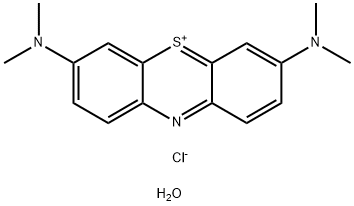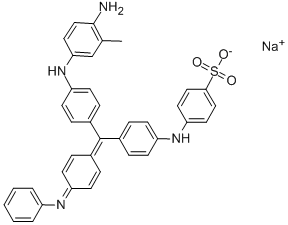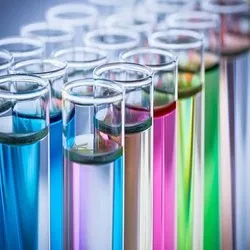Methylene Blue
Synonym(s):Methylene blue;Methylthioninium chloride;Basic Blue 9;Methylene Blue hydrate;Methylene Blue solution
- CAS NO.:61-73-4
- Empirical Formula: C16H18ClN3S
- Molecular Weight: 319.85
- MDL number: MFCD00012111
- EINECS: 200-515-2
- SAFETY DATA SHEET (SDS)
- Update Date: 2025-12-26 08:49:36

What is Methylene Blue?
Toxicity
LD50 = 1180 mg/kg ( Rat ).
Description
Methylene blue is one of the oldest organic dyes. It was first prepared in 1876 by H. Caro—BASF’s research director at the time—for use as a cotton dye. In 1880, microbiologist R. Koch established it as a medical stain. It is also used as an indicator for redox reactions, a photosensitizer for generating singlet oxygen, and a drug to treat methemoglobinemia, among other conditions. Until recently, dyestuff-grade methylene blue was used in medicine, but?a pharmaceutical grade is now under development.
Chemical properties
Methylene blue is a heterocyclic aromatic chemical compound with the molecular formula C16H18N3SCl. It has many uses in a range of different fields, such as biology and chemistry. At room temperature it appears as a solid, odorless, dark green powder, that yields a blue solution when dissolved in water. The hydrated form has 3 molecules of water per molecule of methylene blue. Methylene blue should not be confused with methyl blue, another histology stain, new methylene blue, nor with the methyl violets often used as pH indicators.
The Uses of Methylene Blue
Methylene Blue, 1% w/v aqueous solution is used as a dye in different staining procedures viz. Wright's stain and Jenner's stain. It also serves as an indicator and medicine. Further, it is used to examine RNA and DNA under the microscope or in a gel. It is widely used as a redox indicator in analytical chemistry. It is also used in the sulfide analysis.
The Uses of Methylene Blue
A useful inhibitor of cGMP-mediated processes and a useful stain
Background
Methylene blue is an oxidation-reduction agent. The intravenous form of methylene blue is approved by the FDA for the treatment of pediatric and adult patients with acquired methemoglobinemia. Historically, it has been widely used in Africa to treat malaria, but now it disappeared when chloroquine (CQ) and other drugs entered the market. Its use as an urinary tract antiseptic has also been investigated.
Methylthioninium chloride (INN, or methylene blue, proposed trade name Rember) is an investigational drug being developed by the University of Aberdeen and TauRx Therapeutics that has been shown in early clinical trials to be an inhibitor of Tau protein aggregation. The drug is of potential interest for the treatment of patients with Alzheimer's disease.
Indications
Indicated for the treatment of pediatric and adult patients with acquired methemoglobinemia.
Other clinical applications of methylene blue include improvement of hypotension associated with various clinical states, an antiseptic in urinary tract infections, treatment of hypoxia and hyperdynamic circulation in cirrhosis of liver and severe hepatopulmonary syndrome, and treatment of ifofosamide induced neurotoxicity.
What are the applications of Application
Methylene blue is a polyaromatic stain
Definition
ChEBI: An organic chloride salt having 3,7-bis(dimethylamino)phenothiazin-5-ium as the counterion. A commonly used dye that also exhibits antioxidant, antimalarial, antidepressant and cardioprotective properties.
Preparation
MethyleneBlue45,C.I. 52 015 [61-73-4], is obtained by oxidation of 4-aminodimethylaniline in the presence ofsodium thiosulfate to give the quinonediiminothiosulfonic acid, reaction with dimethylaniline, oxidation to the indamine, and cyclization to give the thiazine.
General Description
Methylene blue, also known as methylthioninium chloride, is a photoactive phenothiazine dye. It is a small molecular weight dye, which is effective against Gram positive and Gram negative bacteria.
Hazard
Toxic by ingestion.
Biological Activity
Biological stain and redox indicator. Inhibits tau filament formation (IC 50 = 1.9 μ M). Also inhibits soluble guanylyl cyclase.
Biochem/physiol Actions
Methylene blue (MB) is a highly recognized histological dye. It plays a vital role in microbiology and pharmacology. It has been employed in staining living organisms and in methemoglobinemia treatment. MB exhibits maximum absorption at 664nm. Exposure to methylene blue leads to various health hazards such as increased heart rate, vomiting, shock, Heinz body formation, cyanosis, jaundice, quadriplegia and tissue necrosis in humans
Clinical Use
Methylene blue is 3,7-bis(dimethylamino)-phenazathioniumchloride (Urised). The compound occurs as a dark greencrystalline powder with a metallic appearance that is solublein water (1:25) and alcohol (1:65).
Methylene blue has weak antiseptic properties that makeit useful for the treatment of cystitis and urethritis. The actionof methylene blue is considered to be bacteriostatic.The compound colors the urine and stool blue green.
Safety Profile
Poison by ingestion,intraperitoneal, intravenous, and subcutaneous routes.Human systemic effects: cyanosis, blood changes.Experimental reproductive effects. Mutation datareported. When heated to decomposition it emits verytoxic fumes of NOx, SOx, and
Veterinary Drugs and Treatments
Methylene blue is used primarily for treating methemoglobinemia
secondary to oxidative agents (nitrates, chlorates) in ruminants. It
is also employed occasionally as adjunctive or alternative
therapy
for cyanide toxicity.
Intra-operative methylene blue is also being used to preferentially
stain islet-cell tumors of the pancreas
in dogs in order to aid in
their surgical removal or in determining the animal’s prognosis.
Metabolism
Following distribution into tissues, rapidly reduced to leukomethylene blue (leucomethylthioninium chloride). Metabolism to leucomethylene blue may be less efficient in neonates than in older individuals.
Purification Methods
Crystallise the chloride from 0.1M 664 2HCl (16mL/g), the crystals are separated by centrifugation, washed with chilled EtOH and diethyl ether, and dried under vacuum. Crystallise it from 50% aqueous EtOH, wash it with absolute EtOH, and dry it at 50-55o for 24hours. It has also been crystallised from *benzene/MeOH (3:1). It has been salted out with NaCl from a commercial concentrated aqueous solution, then crystallised from water, and dried at 100o in an oven for 8-10hours. [Beilstein 27 III/IV 5152.]
Properties of Methylene Blue
| Melting point: | 190 °C (dec.)(lit.) |
| Density | 1.0 g/mL at 20 °C |
| refractive index | n20/D1.347 |
| Flash point: | 45 °C |
| storage temp. | room temp |
| solubility | Soluble in water, ethanol, ethylene glycol, methyl cellosolve |
| form | Liquid |
| pka | 2.6, 11.2(at 25℃) |
| Colour Index | 52015 |
| color | Green |
| Specific Gravity | 0.98 |
| Odor | Odorless |
| Water Solubility | 40 g/L (20 ºC) |
| λmax | 661 nm |
| Merck | 14,6060 |
| BRN | 3641570 |
| Biological Applications | Detecting microorganisms; treating diabetic retinopathy,macular degeneration,malignant uveal melanomas,erysipelas,hidradenitis suppurativa,inflammation,skin diseases |
| NIST Chemistry Reference | Methylene blue(61-73-4) |
| EPA Substance Registry System | Methylene blue (61-73-4) |
Safety information for Methylene Blue
| Signal word | Warning |
| Pictogram(s) |
 Exclamation Mark Irritant GHS07 |
| GHS Hazard Statements |
H302:Acute toxicity,oral |
| Precautionary Statement Codes |
P264:Wash hands thoroughly after handling. P264:Wash skin thouroughly after handling. P270:Do not eat, drink or smoke when using this product. P301+P312:IF SWALLOWED: call a POISON CENTER or doctor/physician IF you feel unwell. P501:Dispose of contents/container to..… |
Computed Descriptors for Methylene Blue
Methylene Blue manufacturer
New Products
4,4-Difluoropiperidine hydrochloride tert-butyl 9-methoxy-3-azaspiro[5.5]undecane-3-carboxylate Indole Methyl Resin N-Isopropylurea N,N-Dicyclohexylcarbodiimide(DCC) MELDRUMS ACID 5-METHYLISOXAZOLE-4-CARBOXYLIC ACID Magnessium Bis glycinate Zinc ascorbate 1-bromo-2-butyne 2-acetamidophenol 9(10H)-anthracenone Erythrosin B, 4-Piperidinopiperidine 2-((4-morpholinophenylamino) (methylthio) methylene) malononitrile 2,4-dihydroxybenzaldehyde 3-(4-morpholinophenylamino)-5-amino-1H-pyrazole-4-carbonitrile Methyl 2-methylquinoline-6-carboxylate 2,6-dichloro-4-nitropyridine 4-Bromo-2-chlorobenzonitrile 2-(benzylamino)acetic acid hydrochloride 4-(tert-Butoxycarbonylamino)but- 2-ynoic acid 3,4-dihydro-2H-benzo[b][1,4]dioxepine 1-Phenyl-1-cycloprppanecarboxylicacidRelated products of tetrahydrofuran







![2-[[(2-ethylphenyl)(2-hydroxyethyl)amino]methyl]-3,3-difluoro-Propanenitrile](https://img.chemicalbook.in/CAS/GIF/2647-14-5.gif)
You may like
-
 Methylene Blue CAS 61-73-4View Details
Methylene Blue CAS 61-73-4View Details
61-73-4 -
 Methylene Blue API MANUFACTURER INDIAView Details
Methylene Blue API MANUFACTURER INDIAView Details
61-73-4 -
 Methylene Blue Powder, 25kg Bag, DrumView Details
Methylene Blue Powder, 25kg Bag, DrumView Details
122965-43-9 -
 Methylene Blue 2B Crude, Jar & Hdpe DrumView Details
Methylene Blue 2B Crude, Jar & Hdpe DrumView Details
26283-09-0 -
 Methylene BlueView Details
Methylene BlueView Details
61-73-4 -
 Methylene Blue (Zinc Free)View Details
Methylene Blue (Zinc Free)View Details
61-73-4 -
 Methylene Blue Zinc Free Cas No 61-73-4, 500gm bottleView Details
Methylene Blue Zinc Free Cas No 61-73-4, 500gm bottleView Details
61-73-4 -
 Merck Methylene Blue StainView Details
Merck Methylene Blue StainView Details
61-73-4
